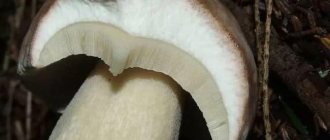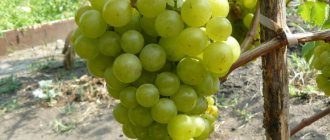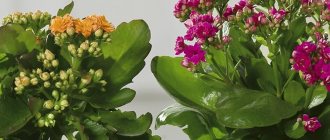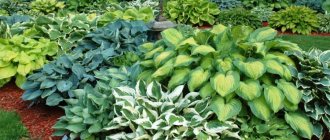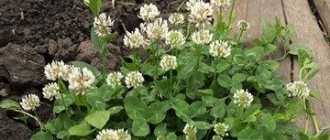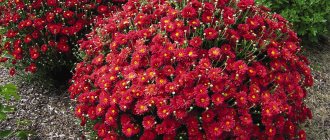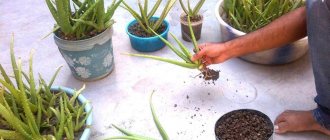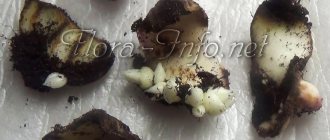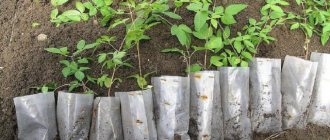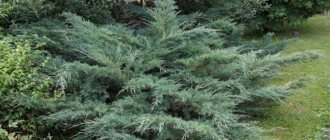Author: Natalya Category: Garden plants Published: February 15, 2019Republished: February 15, 2019Last edits: November 03, 2020
- Growing conditions
- Seed propagation
- White snowberry (Symphoricarpos albus)
plant (lat. Symphoricarpos), or snowberry, or wolfberry , is a genus of deciduous shrubs of the Honeysuckle family. In cultivation, this plant has been decorating parks and squares for more than two hundred years. There are about 15 species in the genus, growing in nature only in Central and North America, except for one species - Symphoricarpos sinensis - which is native to China. The scientific name of the plant is formed from two Greek words that translate as “gather together” and “fruit,” and if you look at the tightly packed berries of the snowberry, you will understand why it was called that. A characteristic feature of the bush is its berries, which remain on the bushes almost all winter and whose seeds serve as food for waxwings, quails, pheasants and hazel grouse.
Planting and caring for snowberries
- Planting: spring and autumn.
- Flowering: from July or August.
- Lighting: bright light or partial shade.
- Soil: any, including rocky and calcareous.
- Watering: only during drought, in the evening, using 1.5-2 buckets of water for each bush.
- Top dressing: in early spring, 5-6 kg of humus or compost, 100 g of potassium salt and the same amount of superphosphate are applied to the root area. In mid-summer, if necessary, the bush is fed with a solution of 50 g of Agricola in 10 liters of water.
- Pruning: in early spring, before the start of sap flow, sanitary and formative pruning is carried out.
- Reproduction: by root shoots, dividing the bush, layering, cuttings, less often by seeds.
- Pests: do not affect.
- Diseases: powdery mildew and gray rot of fruits.
- Properties: the plant is poisonous.
Read more about growing snowberry below.
When and where to plant a plant
The crop is also not demanding on soil composition and grows well on rocky and calcareous soils. It easily adapts to the growing season environment.
The planting area needs to be properly prepared. Without a drainage cover, the snowberry can get wet. Perhaps this is the only disadvantage of a quickly forming shrub. To plant a “snow berry”, you need to dig a hole 0.5 m wide and 0.5 m deep. You need to maintain a distance of 1-1.5 m between the bushes. You will need to add compost or humus to the soil for planting, add dolomite flour, wood ash and superphosphate.
Botanical description
The height of the snowberry shrub reaches from 20 cm to 3 m. It has round, entire, opposite, short-petioled leaves one to one and a half centimeters long, with one or two lobes at the base. Flexible branches in winter do not break under the weight of snow. Flowers of regular shape, greenish-white, red or pink in color are collected in 5-15 pieces in axillary or terminal racemose inflorescences.
The snowberry begins to bloom in July or August. The fruit of the snowberry is an ellipsoidal or spherical juicy drupe with a diameter of 1-2 cm, red, black-violet, but most often white, with oval, laterally compressed seeds. The pulp of the white fruit resembles sparkling grainy snow. The snowberry fruit is inedible. The plant is a honey plant.
In ornamental gardening, the white or brushy snowberry has gained the greatest popularity due to its gas and smoke resistance, and the hedge of snowberry most often attracts the eye. The snowberry flower with pink fruits does not feel comfortable in cool climates; it prefers warm winters and black soil.
- How to grow anemones from seeds
Snowberry bush in landscape design
For the garden you can use this plant, both in single planting and in group planting. The bush will decorate the central part of the flower garden. And also, a snowberry hedge will be an excellent zoning of the site space. Beautiful white, red, as well as original purple clusters will become a bright accent in the garden design. And the delicate pink snowberry bush will create a romantic atmosphere.
Snowberry bush in the autumn garden
Almost all types and varieties of plants have wide, spreading crowns, which look like a chic bouquet in an open area, both in the warm season and in winter. It is appropriate to erect fences only if there is sufficient territory. Otherwise, they will look like thickening and not dividing the garden.
Planting snowberries in open ground
When to plant
One of the main advantages of the shrub, in addition to its decorative effect, is its unpretentiousness. It can grow in full sun or partial shade, in moist or dry soil. If you plant a snowberry on a crumbling slope, its dense rhizomes will stop erosion and soil collapse. Planting snowberries in open ground is done both in spring and autumn, but whenever you start doing this, the soil on the site needs to be prepared in advance.
How to plant
If you are planning to plant a hedge, choose two to four year old snowberry seedlings for this purpose. Stretch the twine along the line of the intended fence and dig a trench along it about 40 cm wide and up to 60 cm deep. 4-5 bushes are planted per linear meter of the trench. When planting solo or in groups, the bushes are placed at a distance of 120-150 cm from each other. The size of the pit in this case should be 65x65 cm.
Holes or trenches are dug in advance: for autumn planting - a month in advance, for spring planting - in the fall. Preliminary preparation is especially important if the site has loamy or clayey soil - before planting the seedlings, the soil in the hole must settle. A layer of crushed stone and a fertile soil mixture prepared from coarse river sand, peat and humus or compost are placed in the pit with the addition of 200 g of dolomite flour, 600 g of wood ash and 200 g of superphosphate for each plant.
Planting of the snowberry is carried out in such a way that after trampling the soil in the tree trunk circle, watering and settling of the soil in the hole, its root collar is at the level of the surface of the site, but half an hour before placing the plant in the hole, it is advisable to dip its roots in a clay mash. The seedling is watered daily for the first 4-5 days.
Rules for a healthy bush
Growing wolfberry on your own plot will not take much time and effort from the gardener. Snowberry White is unpretentious to both soil and environmental conditions. With average rainfall, the bush does not need additional watering.
The plant thrives in polluted environments and near highways.
Despite the fact that the snowman is not picky, for best results it is necessary to adhere to certain care conditions:
- choose the right place;
- prepare the soil for planting;
- disembark;
- cut in a timely manner.
Ideal place
Despite the fact that the snowfield feels normal in any conditions of light and shade, it is still preferable to opt for an illuminated area of land. With little lighting, a low bush will bloom poorly, and its branches will become very elongated and disrupt the harmonious image of the green inhabitant.
Experts recommend planting wolfberry on the outside of the dacha area to protect its residents from exhaust fumes and road smoke.
Soil preparation
The plant can be planted both in spring and autumn. In the first and second cases, it is necessary to prepare the soil for the root system of the bush. To plant snowfields in the soil from April to May, a hole is dug six months in advance, namely in the autumn months. If it is planned to form green spaces from September to October, then a hole in the ground is formed at least 30 days before the event.
Experienced summer residents also recommend preparing the soil for shrubs. To do this, a layer of drainage, for example, broken brick or gravel, is laid at the bottom of the hole or trench, if it is planned to create a hedge from the plant. Provided that the soil is heavy and clayey, it is necessary to make a special soil mixture. To do this, add in equal parts:
- humus;
- peat;
- coarse sand.
Also, the following fertilizers must be added to the soil mixture:
- superphosphate (200 g);
- potassium sulfate (100 g);
- wood ash (500-600 g).
If a hedge is planted, then the listed set of fertilizers and soil mixture is applied under each snow bush.
Planting a plant in the ground
Having decided on a place for planting, digging a hole and preparing the soil, you can proceed directly to planting the White snowberry in open ground. It is worth remembering that with a single planting, a hole is dug measuring 60 x 60 cm; with the trench method, its width is 40 cm and depth 50-60 cm. The distance from a single standing wolfberry to other neighbors on the site should be at least 130 cm. If If a green hedge is created, then 4-5 seedlings are dug into the ground per 1 linear meter.
The most suitable for planting are snow bushes that are 2-3 years old.
It is worth remembering that if a plant is replanted, then it must be dug up from its original place with a clod of native soil, since in this way it will take root faster. If you plant a young snowfield bought in a store in the ground, then its roots should be washed with “earthen mash” before doing this.
Watering and fertilizing
After a garden resident has “settled” in a permanent place, it needs to be watered regularly. Usually the procedure is performed in the evenings, when the sun is no longer at its zenith. After planting, it is recommended to moisten young green spaces daily for a week. Further, if the weather in summer is hot and dry, then the seedlings are “watered” with 2 liters of water 1-2 times every 7 days.
A middle-aged snowberry bush requires infrequent, but abundant moisture in a volume of 20 liters per 1 square meter. meter.
Regular seasonal application of fertilizers to the soil will have a positive effect on the health and appearance of the White snowberry and its other varieties. In the spring, humus can be added to the tree trunk of the bush, and in the summer it can be fed with a complex mineral preparation. In the autumn, it will not be superfluous to dig superphosphate (100 g) or potassium sulfate (50-70 g) near the snowfield. The procedure will stimulate the flora representative to good development and abundant fruiting.
Taking care of the branches
An integral part of caring for the White snowberry is regular trimming of its branches. At an early age, it can be both formative and sanitary. And in adulthood, it is often necessary to resort to rejuvenation of the plant.
The snowberry tolerates any type of pruning of branches well, which is why it is not spared when pruning. Formative cleaning is carried out in early spring, before the buds awaken. During this period, you can carry out a sanitary procedure, ridding the plant of dried, broken or frozen branches. It is also necessary to ensure that the bush does not thicken.
Wolfberry has the amazing ability to fully recover even after severe winter freezing.
Bushes that have reached the age of 7-8 years require a rejuvenating haircut with pruning shears or sharp garden shears. In this case, the procedure is also carried out in the spring before the juices are released. The snowberry branches are cut off completely, with the exception of a few leading ones, and they should not exceed 50-60 cm. After the plant is trimmed, the sections, which are 70-80 cm in diameter, are treated with garden varnish/country putty.
Disinfectant Recipe
The method for preparing disinfectant resin for treating tree cuts is quite simple. To do this, the summer resident will need:
- animal fat (preferably pork or beef);
- rosin;
- wax or paraffin;
- linseed oil.
You need to melt 1 part each of fat, rosin and wax over the fire. Add ¼ part of flaxseed oil to the slurry. Next, zinc oxide is added to the resulting base, the percentage of which should be from 15 to 20% of the total volume. After cooling, the garden pitch is ready and can be used to treat wood “wounds”.
If you add 1/10 ethyl alcohol to the mixture and stir vigorously while it cools and thickens, the resulting summer putty will also have frost-resistant qualities.
Caring for snowberries in the garden
Growing conditions
Due to the absolute unpretentiousness of the snowberry, you could not care for it at all, but if you give it a minimum of time and attention, it will reward you with well-groomed and luxurious beauty. Caring for snowberries consists of mulching the tree trunk immediately after planting with a layer of peat 5 cm thick, loosening the soil to a depth of 8-10 cm, removing weeds, fertilizing, pruning, watering and protecting from insects and pests, if the need arises.
Watering the snowberry is carried out only in dry seasons - one and a half to two buckets of water are poured under each bush in the evening. If the summer is relatively humid, then there is no need to water the snowberry at all. It is more convenient to weed and loosen the soil in the tree trunk circle after rain or watering. In autumn, the soil around the snowberry is dug up.
In the spring, 5-6 kg of compost or humus, 100 g of superphosphate and the same amount of potassium salt are added to the plant’s trunk circle. The second time, if necessary, the snowberry bush is fed in the middle of the season with a solution of 50 g of Agricola in 10 liters of water.
Transfer
If for some reason you decide to replant the snowberry, do it as quickly as possible, before the bush has grown a powerful root system. The plant tolerates replanting easily, and it is carried out in the same order and at the same time as the initial planting. The main thing in this process is to dig up the bush correctly, causing as little damage to its roots as possible. The fact is that the radius of the feeding area of an adult snowberry bush is from 70 to 100 cm, that is, in order to dig it up without dire consequences for health, you need to dig it in a circle at a distance of at least 70 cm from the bush.
A haircut
The snowberry tolerates pruning easily. The best time to trim the crown is early spring before the sap begins to flow. All broken, dry, frozen, thickening, too old and damaged by disease or pest branches are removed, and healthy ones are shortened by half or at least a quarter.
Don’t be afraid to prune the bush - the flower buds of the snowberry are formed on the shoots of the current year, and after pruning the bush is easily restored. Cuts on branches thicker than 7 mm must be treated with garden varnish. On bushes older than eight years, the leaves and flowers are small, the shoots are weak and short. If you notice this, it means it’s time to carry out rejuvenating pruning “to the stump” at a height of 50-60 cm. Over the summer, young strong shoots form from dormant buds on the remains of the branches.
Pests and diseases
The snowberry is very resistant to diseases and pests, and most likely they avoid it because the snowberry is poisonous. Extremely rarely, but still, the plant is affected by powdery mildew and gray rot of fruits. To prevent the snowberry from becoming infected with these fungal infections, in early spring, before the buds swell, the bushes are treated with a three percent solution of Bordeaux mixture. If you have not carried out the treatment and the plant is sick, spray the bush with one of the modern fungicides - Thiovit Jet, Fundazol, Topaz, Skor, Quadris, Topsin or some other drug from this series.
Types of shrubs
In the territories of Central and South America, almost all varieties of this ornamental bush growing in the wild are found. But not all of them take root in our climate zone.
Snowberry white
Snowberry white
The shrub is very popular and one of the most undemanding plants, which has been cultivated since the 19th century.
White snowberry is characterized by yellowish-gray thin branches that form a hemispherical crown, hanging down to the ground. In early spring, the buds turn into bluish-green foliage, whose shape resembles an egg, and the length of one leaf is, on average, about 5-6 cm. The leaves of the white snowberry have a smooth edge, with small blades.
The flowers are greenish-pink in color, bell-shaped, small in size and clustered in the axils of the foliage. The flowering process is very long, begins in early July and continues until September. In mid-August, small round-shaped fruits appear, which can be preserved even in winter.
White snowberry is very unpretentious to the composition of the soil and can easily please owners of plots with calcareous or rocky soil. In addition, white snowberry tolerates lack of moisture during dry periods and grows well in shade or partial shade.
Strong and non-bending branches are excellent for forming a hedge, which attracts the attention of landscape designers or just gardeners for decorating the garden.
Chinese snowberry
Symphoricarpos sinensis or Chinese snowberry is the only plant species that cannot be found in the wild of Central and South America, it grows in the western provinces of China.
A distinctive feature of this ornamental bush is its fruits, which have a dark, almost black color.
Pink snowberry
Pink snowberry
Pink snowberry owes its name to its pink or purple fruits. The shrub is very common in Western European gardens and is slightly less common in Russia and the CIS countries. In its homeland, in North America, the plant is called “Indian currant” or “coral berry.”
Pink snowberry has dark green, rounded leaves and thin shoots that droop strongly to the ground at an early age. The color of the berries has a purple-pink hue, and the size, for the most part, does not exceed 0.5-0.6 cm.
This type of snowberry is inferior in terms of frost resistance to its relative, the white snowberry, but still found its fans for cultivation in domestic conditions.
Snowberry Shenot
Snowberry Shenot
The ornamental shrub is a hybrid of pink snowberry. It quickly gained popularity, because its small size allows it to easily withstand negative temperatures.
The pink berries are unsuitable for consumption, but are excellent honey plants. The foliage has a pointed shape, and the shoots are very long and take root easily.
Snowberry plant Doorenboza
Snowberry Dorenboza
The Doorenboza snowberry has long won the sympathy of both landscape architects and lovers of beautiful plants in the garden thanks to its chic appearance.
The ornamental shrub was bred by breeders from Holland.
However, the Doorenboza snowberry does not tolerate frost very well, therefore, in order to admire first the beautiful flowering, and then the wonderful pink berries in the next spring-summer period, the bushes must be covered for the winter.
Reproduction of snowberry
Snowberry propagates by seeds, cuttings, layering, root shoots and dividing the bush.
Seed propagation
This method of reproduction is the most labor-intensive of all, in addition, it will take a lot of time, but if you are not in a hurry, then why not try it? Separate the seeds from the fruit pulp, place in a nylon stocking and squeeze well. Then place the seeds in water poured into a small container, shake well and let the suspension settle: the remaining pulp will float and the seeds will settle. Remove them and dry them.
- Cotoneaster: planting and growing, types and varieties
It is better to sow seeds before winter, but not in open ground: the seeds are very small, and when the snow melts, they can come off with it. Snowberry seeds are sown in boxes filled with fertile soil made from equal parts of river sand, peat and humus, and they are “salted” with sand on top and tightly covered with glass. Water the crops using a fine sprayer or in a tray so as not to wash the seeds out of the substrate. The first shoots will appear in the spring, and at the end of the season they can be planted directly into open ground.
Reproduction by root shoots
Many root suckers appear around the snowberry bush - large dense clumps are formed from them. This feature of the snowberry allows it to move from its landing site and grow. Dig up one of these clumps and replant it. This will also save the bush from thickening.
Dividing the bush
In early spring, before the sap begins to flow, or in the fall after leaf fall, an overgrown snowberry bush is dug up, divided into parts and the divisions are planted in the same way as the seedlings during the initial planting. Each part should have well-developed roots and strong young branches. And do not forget, after dividing the bush, to treat the cuts on the roots with crushed coal.
Reproduction by layering
In early spring, bend a low-growing young branch, place it in a groove made in advance in the soil, secure it in this position and cover it with soil, leaving the top above the soil surface. Take care of the layer all summer: water it along with the bush, fertilize it, loosen the soil around it. In the fall, the rooted cuttings are separated from the mother plant with pruning shears and transplanted to a permanent place.
Propagation by cuttings
Snowberry can be propagated by green and woody cuttings. Lignified pieces 10-20 cm long with 3-5 buds are harvested in late autumn or early winter and stored until spring in the basement, placed in sand. You need to cut the top edge above the kidney, and the bottom edge obliquely.
Green cuttings are harvested early in the morning, at the beginning of summer, as soon as the snowberry flowering has ended. You need to cut off large, well-developed and mature shoots. Determining whether a shoot is mature enough for propagation by cuttings is very simple: it is bent, and if the shoot breaks with a crunch, this confirms its maturity. After cutting, the cuttings are immediately placed in a container of water.
Green or lignified cuttings are planted in boxes with a substrate of the same composition as for seed propagation. Planting depth is no more than 5 mm. The box with cuttings is placed in a greenhouse or greenhouse and rooted in conditions of high air humidity and moderate substrate humidity. By autumn, the cuttings will have acquired a stable root system, and they are transplanted into the ground, covered with leaves and spruce branches for the winter.
Medicinal properties
The chemical composition of snowberry has been little studied, so the plant is almost never used in folk medicine.
But in North America, where the shrub is found throughout the territory, indigenous people have learned to use it for healing. They know about the antimicrobial and disinfectant properties of white snowberry and prepare potions from its berries, bark and leaves to treat wounds.
Crushed leaves of the shrub are used to combat skin ulcers. Compresses made from crushed fruits are used in the treatment of burns and cracks on the skin surface. An infusion of the bark from the plant is good for sore throats, as well as many other diseases:
- tuberculosis;
- menstrual pain;
- venereal diseases;
- stomach pathologies;
- cold.
Despite these properties, it is not recommended to treat yourself with these poisonous drugs without consulting a specialist.
The original berries of the bush are beautiful in appearance, but unpleasant in taste. When poisoned by snowberry fruits, the following symptoms are observed:
- nausea and vomiting;
- paroxysmal pain in the stomach;
- burning in the mouth and throat;
- feeling weak and dizzy;
- stomach upset;
- lethargy.
If the toxic substances of the plant get on the skin and mucous membrane, swelling, redness and irritation of the skin occurs. The victim experiences pain, the intensity of which will depend on the affected area. The individual characteristics of the body also matter.
Read also: The danger of green potatoes: can they be eaten without harm?
When plant poison gets on the skin, it is recommended to immediately rinse the affected area with water. When ingested, symptomatic therapy is carried out. You need to drink milk, which has the property of neutralizing poison, or activated charcoal. If the condition is severe, then you should immediately seek medical help.
Snowberry after flowering
The snowberry tolerates winters in the middle zone without shelter - even highly decorative hybrid plant varieties can withstand cold temperatures down to -34 ºC. But even if the plant freezes in severe frosts, it will completely recover during the growing season. It is advisable to cover young bushes high in soil for the winter.
As you probably already understood, planting a snowberry and caring for it will not take you much time and effort, but its extraordinary fruits will decorate your garden and feed birds almost all winter.
Transplanting snowberry
Young snowberries (up to two years old) tolerate transplantation most easily. Then a powerful root system grows, and the plant takes longer to adapt to new conditions.
| If you damage the roots minimally, the shrub can easily tolerate replanting. |
When digging up an adult bush, you should remember that the roots grow in a radius of 70 cm to 1 m. Therefore, start digging up an adult plant 80 cm from the bush and slowly move towards the middle.
Photo: In an adult snowberry bush, the roots grow from 70 cm to 1 m.
The rules for transplanting are the same as for planting. This applies to both preparation of the planting hole and timing.
Types and varieties
White snowberry (Symphoricarpos albus)
The most famous species of the genus is the white snowberry, also known as the white snowberry, which grows naturally on open slopes, along river banks and in mountain forests of North America from the west coast to Pennsylvania. The height of the white snowberry reaches one and a half meters. This is a deciduous shrub with thin shoots and a rounded crown. The leaf of this species is ovoid or round, simple, notched-lobed or entire, up to 6 cm long, green on the upper side of the leaf blade and bluish on the bottom. Small, soft pink flowers are collected in dense racemose inflorescences located along the length of the entire shoot. The flowering is abundant and so long that at the same time you can see both buds and fruits on the bush - white, elegant and juicy spherical berries up to 1 cm in diameter, which stay on the bush for a very long time.
The winter hardiness of the snowberry is as high as its unpretentiousness to growing conditions. This species has been in cultivation since 1879; it is most often used for group plantings, hedges and borders. Our readers ask: is the white snowberry poisonous or not? Its fruits are inedible, and the substances they contain can cause dizziness, weakness and vomiting. An attractive variety for gardeners is the white snowberry (Symphoricarpos albus var. laevigatus).
Common snowberry (Symphoricarpos orbiculatus)
Or round snowberry, or pink snowberry, or coralberry (Symphoricarpos orbiculatus), in its homeland it was called “Indian currant”. It grows in North America in meadows or along river banks and is a large shrub with thin shoots and small dark green leaves with a bluish underside. Its pink flowers, like those of white snowberry, are collected in short, dense inflorescences. The plant is very beautiful in the fall, when coral or purple-red hemispherical fruits, covered with a bluish coating, begin to ripen along the entire length of the shoots, and the leaves acquire a purple tint.
This type of snowberry is not as winter-hardy as the white one, but its resistance to cold is quite sufficient for wintering in the middle zone. Common snowberry is very popular in Western Europe, especially its varieties Variegatus with an uneven yellowish stripe along the edges of the leaves and Tuffs Silver Age with a white border.
Western snowberry (Symphoricarpos occidentalis)
From the eastern, western and central regions of North America, where it forms thickets along rivers, streams and on rocky slopes. The plant reaches a height of one and a half meters. The leaves are soft green on the upper side and felt-like pubescence on the lower side. The flowering of white or soft pink bell-shaped flowers, collected in dense and short racemes, continues from early June to late August, gradually giving way to the appearance of soft, almost spherical berries of a pale pink or white hue.
- Tulips - garden care
Snowberry (Symphoricarpos oreophilus)
From the western part of North America it grows up to one and a half meters in height. Its leaves are oval or rounded, with slight pubescence. Flowers are paired or single, pink or white, bell-shaped. The fruits are white, spherical, with two seeds. Winter hardiness is average.
Chenault's snowberry (Symphoricarpos x chenaultii)
A hybrid descendant of the common snowberry, or rounded one, and the small-leaved snowberry, characterized by short stature, dense pubescence, sharp leaves up to 2.5 cm long and pink berries with white cheeks. Unfortunately, this hybrid is not frost-resistant.
Henault's snowberry (Symphoricarpos x chenaultii)
Hybrid shrub up to 1.5 m high and the same crown diameter. The leaves are rich dark green on the top and gray on the bottom, open early and fall late, pink flowers are collected in inflorescences, rounded fruits ranging in color from white to purple do not fall from the bush for a long time. The best variety of this species is snowberry Hancock.
Dorenbos snowberry (Symphoricarpos doorenbosii)
It combines a group of hybrid varieties bred by the Dutchman Doorenbos by crossing white snowberry with rounded snowberry and characterized by compactness and abundance of fruits:
- Mather of Pearl is a snowberry with dark green elliptical leaves and white fruits with a slight blush;
- snowberry Magic Berry is distinguished by bright pink fruits that abundantly cover the branches;
- White Hage is a snowberry with a dense, erect bush with small white berries;
- snowberry Amethyst has increased frost resistance. Its bush reaches a height of one and a half meters, the leaves are dark green, the flowers are pinkish, inconspicuous, the fruits are round, white-pink.
In addition to the described species, Chinese, round-leaved, soft, small-leaved and Mexican snowberries are known.
White snowberry berries
Thanks to its original white fruits, the shrub received its name. The small, round, waxy berries are soft to the touch and fit tightly together, forming beautiful and original clusters. It's not often you see branches with red berries, but the rarest is the inky purple color.
Read also Description, benefits and harms of black nightshade
In late autumn the berries are already fully ripened, but with the onset of frost the balls do not fall off. They hold well on flexible branches, descending to the ground. In winter, the fruits often serve as food for many birds. In autumn, they can be mistaken for lumps of snow that decorate graceful shrubs.
Very often, a bush with white berries that click attracts children. Kids play with balls, smashing them on the asphalt with their shoes. At the same time, the berries make a clicking sound, which delights the children.
Most people don't know whether snowberry is edible or not. In fact, the berries are unsuitable for human consumption because they are poisonous. If you eat them in small quantities, they will not cause terrible harm to your health. A large portion of fruits will lead to poisoning of the body. The fruits contain the toxic substance corned beef and another toxin that is still unknown to scientists.
Why is the snowberry dangerous?
Is snowberry poisonous? Many people have eaten the berries of the bush more than once. However, not everyone knows that the plant is poisonous. Snowberry can lead to the development of unpleasant symptoms and overdose.
Intoxication cannot happen by accident - the berries are tasteless and unpleasant. In most cases, small children who eat snowberry fruits out of curiosity suffer. The berries contain an increased amount of saponin and acids. Adults will not experience any discomfort when consuming the fruit; children may develop poisoning.
You will like the article: “ List of poisonous medicinal plants .”
Is the white snowberry poisonous? It is difficult to answer a question like this precisely. It is as safe for animals as it is for an adult in good health.
Features and description of the snowberry
Up to 20-300 cm. Whole leaves are planted on underdeveloped petioles, located oppositely. The branches bend well and do not break under thick snow cover in the winter season.
The buds form racemose inflorescences located in the leaf axils. Petals of various shades. Flowering can be observed in the second decade of summer.
After the inflorescences wither, black-lilac round berries appear. They are 2 cm in circumference and have delicate pearly flesh. It is prohibited to eat them; they provoke dyspeptic disorders.
